MR Spectroscopy
Digital Poster
Spectroscopy & Non-Proton MR
2225 -2249 MRS of J-Coupled Metabolites & Macromolecules
2250 -2274 MRS/MRSI Applications
2275 -2298 MRS: Other
Digital Poster
| Exhibition Hall | 17:00 - 18:00 |
| Computer # | |||
 |
2225. 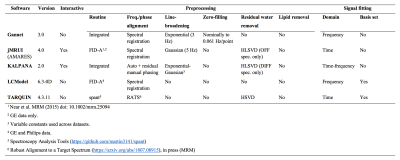 |
101 | Analyzing Big GABA: Comparison of Five Software Packages for GABA-Edited MRS
Mark Mikkelsen, Pallab Bhattacharyya, Pravat Mandal, Deepika Shukla, Anna Wang, Martin Wilson, Ulrike Dydak, James Murdoch, Jamie Near, Georg Oeltzschner, Richard Edden
Given the number of software analysis packages available to the MRS community, surprisingly little attention has been paid to comparing the performance of each, particularly with regard to multi-site and multi-vendor datasets. Standardization of MRS methods will necessarily require that processing and quantification tools also produce comparable outcomes. This abstract describes a comparison of five widely used software packages analyzing multi-site edited MRS data to quantify in vivo GABA+/Cr levels. The overall agreement between the packages was moderate, with packages showing systematic site-to-site biases. Further analysis on a larger cohort of data will aid in determining the cause of these discrepancies.
|
2226. 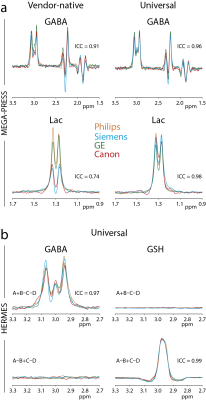 |
102 | A Universal Edited MRS Sequence for 4 Vendors
Muhammad Saleh, Daniel Rimbault, Mark Mikkelsen, Georg Oeltzschner, Anna Wang, Dengrong Jiang, Ali Alhamud, Jamie Near, Michael Schär, Ralph Noeske, James Murdoch, Lars Ersland, Alexander Craven, Gerard Dwyer, Eli Gruner, Li Pan, Sinyeob Ahn, Richard Edden
MEGA-PRESS is the most widely used pulse sequence for edited MRS of low-concentration metabolites, e.g. GABA, glutathione and lactate. However, current implementations of MEGA-PRESS are diverse across MR vendors, leading to differences in the shape and intensity of the final edited signal. We demonstrate a new universal editing sequence (with MEGA and HERMES functionality) for the major MR vendor platforms with standardized RF pulse shapes, durations, amplitudes and sequence timings. Phantom and in vivo experiments show excellent agreement among vendors, including consistency in lineshape and reduced variation in concentration measurements.
|
|
2227. 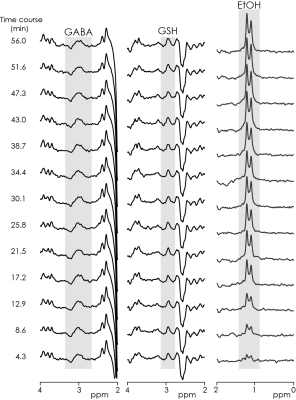 |
103 | Simultaneous edited detection of GABA, glutathione and ethanol using HERMES
Muhammad Saleh, Anna Wang, Mark Mikkelsen, Georg Oeltzschner, Eric Porges , Richard Edden
HERMES allows simultaneous edited detection of multiple low-concentration metabolites in the human brain. Here, HERMES editing of GABA, glutathione (GSH) and ethanol (EtOH)
|
|
2228. 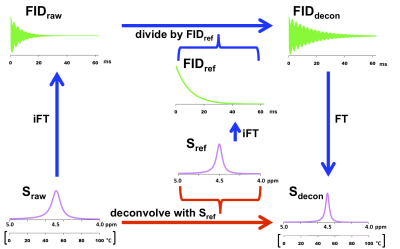 |
104 | Editing MRS lineshapes using the convolution theorem: potential for applications to statistical analysis of heterogeneous tissue
Norbert Lutz, Monique Bernard
The statistical distribution of a number of measurement parameter values in heterogeneous tissues can be analyzed based on MR spectra, using a paradigm recently introduced by us. However, the MR resonances in question are affected by influences on line shape other than those exerted by the measurement parameter to be analyzed, e.g., by magnetic-field inhomogeneity. We demonstrate here that desired and spurious line shape contributions can be efficiently disentangled by judiciously employing the convolution theorem. This method should facilitate future applications of our method of tissue heterogeneity assessment.
|
|
2229. 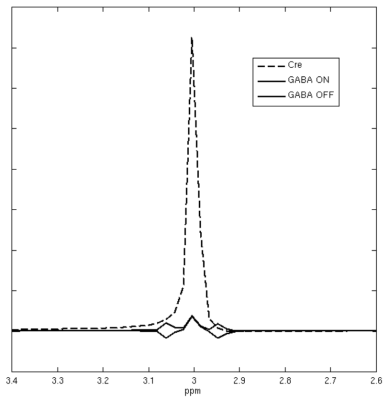 |
105 | GABA Editing with Physiological Noise Suppression using an Improved MEGA-SPECIAL sequence and Principle Component Analysis
Meng Gu, Ralph Hurd, Daniel Spielman
As GABA editing is achieved by eliminating the overwhelming Cre peak using subtraction, discrepancies in Cre amplitude due to physiological noise result in variations in edited GABA. It can be observed the flip of the outer peaks of GABA triplet is in a different dimension from the Cre. It is thus possible to eliminate Cre and its associated physiological noise using principle component analysis (PCA). Simulation and phantom studies showed the physiological noise associated with Cre was eliminated using PCA editing without GABA signal loss. In vivo study demonstrated more consistent GABA measurement using PCA editing than regular editing.
|
|
2230. 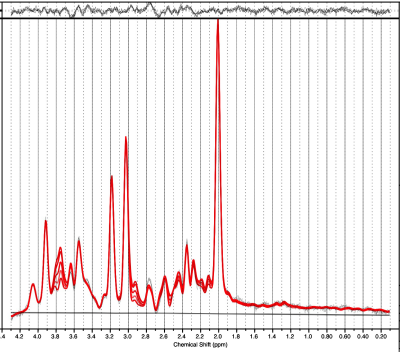 |
106 | Quantification of Glutathione and Ascorbate in the Human Brain using Short-TE PRESS.
Meng Gu, Ralph Hurd, Daniel Spielman
The SNR advantage of short-TE methods over long-TE editing-methods provided a compelling motivation for reliable quantification of glutathione using LCModel. In this study, we improved the accuracy of the glutathione basis by using an experimental glutathione in our otherwise synthetic LCModel basis. We further added ascorbate as a complementary measure of oxidative stress. Validation was made using a brain metabolite titration phantom with a matrix of glutathione and ascorbate. The near perfect linear regression results demonstrated that both GSH and ASC at physiological concentrations can be reliably quantified using LCModel. In vivo study also showed consistent glutathione quantification.
|
|
2231. 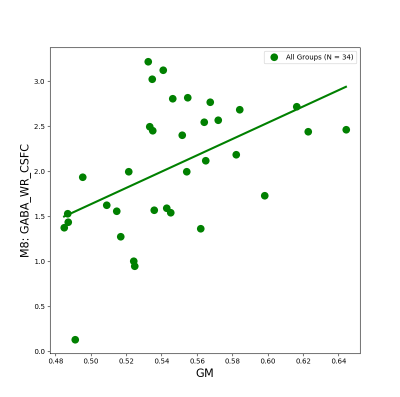 |
107 | Optimal Analysis Strategies for GABA Quantification with 1H J-Edited MRS
Jeffry Alger, Joseph O'Neill, Ronald Ly, Guldamla Kalender, Shantanu Joshi, Katherine Narr, Mary O'Connor, Jennifer Levitt
This study evaluated the performance of 9 unique methods of deriving GABA and GABA+ from J-edited-single-voxel-MRS using a set of high-quality spectra obtained from the anterior middle cingulate cortex in 34 pediatric human subjects. The results indicate that spectral integration produces the most consistent between-subject measure of GABA+ and that non-linear least-squares fitting that includes macromolecule confound spectral models together with GABA spectral models best produces the expected positive correlation between voxel gray matter content and GABA.
|
|
2232. 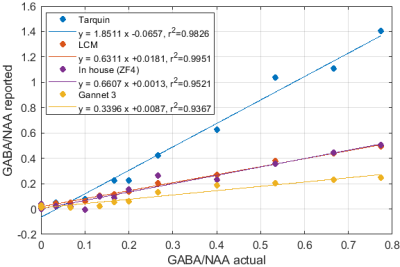 |
108 | Quantification of edited magnetic resonance spectroscopy: a comparative phantom based study of analysis methods
Christopher Jenkins, Max Chandler, Frank Langbein, Sophie Shermer
A calibrated series of MRS phantoms is used to compare the performance of common spectroscopy analysis tools in the quantification of GABA-edited spectroscopy data. Varied GABA concentration, and simulated spectra provide a ground truth with which to compare.
|
|
2233.  |
109 | Functional magnetic resonance spectroscopy towards detection of initiated release of GABA in chemogenetically modified mice
Inbar Zohar, Inbar saraf-sinik, Ofer Yizhar, Assaf Tal
Dynamics of γ -aminobutyric acid (GABA) concentrations in the brain has been shown to vary under a variety of activation paradigms using functional magnetic resonance spectroscopy (fMRS). To provide better understanding of the underlying cellular mechanisms involved, we used fMRS on chemogenetically engineered mice at ultrahigh fields (15.2T), allowing us to investigate the dynamics of metabolites in response to activation of a specific neuronal population (GABAergic) in the reticular nucleus. fMRS data from four mice was analyzed using LCModel and did not show any significant change in GABA.
|
|
2234. 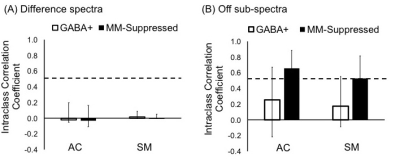 |
110 | Reliability of in vivo Glx measurements from GABA-edited MRS at 3T
Tiffany Bell, Elodie Boudes, Rachelle Loo, Gareth Barker, David Lythgoe, Richard Edden, R Lebel, Martin Wilson, Ashley Harris
To measure glutamate and GABA, two spectroscopy sequences are typically performed. Here we investigate the reliability of measuring Glx (glutamate+glutamine) from the same editing sequence used to measure GABA (MEGA-PRESS). We found that Glx measured using the unedited (“off”) sub-spectra of a macromolecule suppressed MEGA-PRESS sequence (MM-suppressed, TE=80ms) moderately agreed with Glx measured using a short-echo PRESS sequence. However, Glx measured using the off sub-spectra of a GABA+ (TE=68ms) MEGA-PRESS sequence and the co-edited Glx signal from the difference spectra of both GABA-edited MEGA-PRESS sequences showed poor agreement.
|
|
2235.  |
111 | Simultaneous modelling of Hadamard encoded spectra for GABA and GSH using LCModel
Diana Rotaru, Georg Oeltzschner, Richard Edden, David Lythgoe
Low-concentration metabolites like γ-aminobutyric acid (GABA) and glutathione (GSH) can be measured at 3T using spectral-editing magnetic resonance spectroscopy methods like MEGAPRESS, HERMES or HERCULES. We propose a novel analysis approach based on
|
|
2236 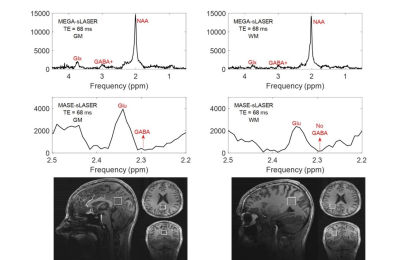 |
112 | Macromolecule free measurement of GABA with MASE-sLASER and MEGA-sLASER sequences in the human brain at 7T Video Permission Withheld
Seyedmorteza Rohani Rankouhi, Donghyun Hong, David Norris
MEGA edited 3 ppm signal can be severely contaminated with macro-molecules. Using two distinct acquisition methods of MASE-sLASER and MEGA-sLASER both at TE = 68 ms at 7T, we show the feasibility of macromolecule free estimation of GABA with LCModel. The presence of GABA line at 2.28 ppm in the spectra acquired with both techniques plays a crucial role for this.
|
|
2237. 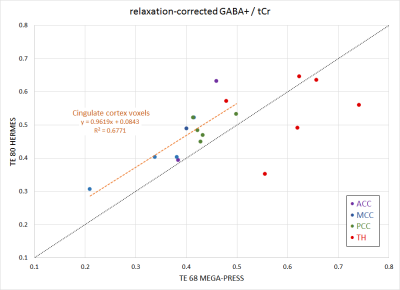 |
113 | LCModel comparison of MEGA-PRESS and HERMES for GABA (and GSH) editing at 3T
James Murdoch, Ferdinand Schweser, Muhammad Saleh, Richard Edden
HERMES is a new Hadamard-based editing sequence that allows for the simultaneous acquisition of overlapping metabolite signals – most notably GABA and glutathione (GSH) at TE 80. As such, HERMES is an alternative to conventional GABA measurement using TE 68 MEGA-PRESS, providing GSH information “for free.” In this work, we showed in a series of matched-voxel spectra that %SD values from LCModel were on average only slightly larger for HERMES than for MEGA-PRESS, suggesting that only a small price is paid in terms of GABA sensitivity.
|
|
2238.  |
114 | Localised 2D J-resolved spectroscopy: Enhanced sensitivity and accelerated acquisition of brain metabolites
Christopher Wickens, Stephen Sawiak, Keri Carpenter, Adrian Carpenter, Christopher Rodgers
Proton 1D MR spectroscopy has been used to quantify alterations in cerebral metabolite concentrations to investigate neurological diseases. However, the J-coupling found in key metabolites produce multiplets which result in highly overlapped signals, complicating signal quantification. 2D J-resolved spectroscopy (JPRESS) allows distribution of coupled signals into a second perpendicular dimension, reducing signal overlap. Unfortunately, the translation of 2D-JPRESS into a commonly used clinical tool has not been achieved due to limited post-processing strategies and long scan times. Here, a simple processing strategy to significantly enhance signal sensitivity and a technique to accelerate JPRESS by 30% are presented.
|
|
2239.  |
115 | Longitudinal relaxation times of macromolecules and their suppression in MEGA-PRESS 1H-MR-brain spectra at 3 T
Andreas Masek, Alexander Gussew, Jürgen Reichenbach
Taking advantage of the adiabatic inversion based macromolecule (MM) suppression approach, the MM contamination of the neurotransmitter GABA can be significantly reduced in MEGA-PRESS 1H-MR brain spectra. In this work, the longitudinal relaxation times (T1) of brain macromolecules were determined in posterior cortex of healthy subjects in order to adjust the inversion delays for MEGA-PRESS based measurements of pure GABA. Compared to main brain metabolites, T1 times of MMs are significantly shorter and further reveal a very low inter-individual variation, which allows us to use the MM nulling approach without substantial T1 weighing related attenuations of metabolite signals and further to apply fixed TI settings instead of performing individual T1 measurements in future studies.
|
|
2240. 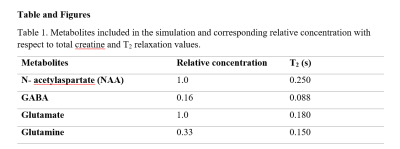 |
116 | Quantification of Glutamate/Glutamine using LCModel for MEGA-PRESS sequence at 3 T
Hu Cheng, Sharlene Newman
We conducted a Monte-Carlo simulation to investigate the quantification of glutamate (Glu) and glutamine (Gln) using MEGA-PRESS and LCModel at 3 T. The results demonstrate that both glutamate and glutamine can be reliably quantified along with Gamma-aminobutyric acid if the spectrum linewidth is smaller than 0.06 ppm. However, our in vivo results showed a higher ratio of Glu/Gln, which is out of the physiological range measured by other methods. Our work suggests that glutamate and glutamine can be quantified at high accuracy in theory but the accuracy might be compromised in practice by other factors that affects the spectrum quality.
|
|
2241. 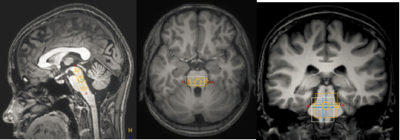 |
117 | A pilot study on the GABA+ level in midbrain of healthy volunteers using MEGA-PRESS technique Presentation Not Submitted
Yulu Song, Tao Gong, Fei Gao, Richard Edden, Weibo Chen, Guangbin Wang
Gamma-aminobutyric acid (GABA) in midbrain is insignificant to be measured. To determine the GABA+ level, we employed Mescher-Garwood point-resolved spectroscopy (MEGA-PRESS) by a small region of interest (ROI)(1.0 × 2.5 × 3.0 cm), which is a new technique that could precisely measure the level of the inhibitory neurotransmitter. The distribution is 2.47 ±0.66 (χ±SD),and it is prove that there was no correlation of GABA+ level with age in healthy volunteers.
|
|
2242. 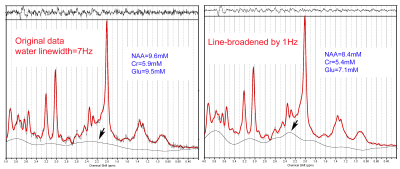 |
118 | Comparison of baseline effect on short-TE and 1D JPRESS MRS data fitting
Yan Zhang, Jun Shen
For in vivo MRS spectral fitting, a baseline is often used to model background signals. The existing algorithms including LCModel rely on the linewidth to distinguish metabolite peaks from the background signals. In this work, we show that the fitted short-TE baseline strongly depends on metabolite linewidth due to large baseline-metabolite covariances. This dependence negatively affects metabolite quantification using short-TE MRS, resulting in large errors in metabolite concentrations. We also demonstrate that this baseline problem can be largely eliminated using 1D JPRESS which benefits from its substantially reduced background signals.
|
|
2243. 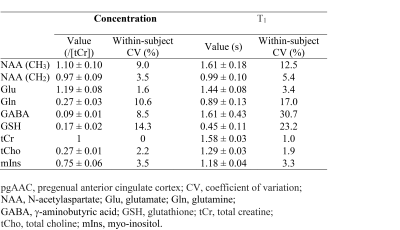 |
119 | Determination of Macromolecule Baselines by Variable Inversion-Recovery of Metabolites
Li An, Christopher Johnson, Milalynn Victorino, Jun Shen
A novel approach for determining macromolecule baselines at medium TE was proposed. Inversion recovery was combined with spectral editing to acquire six sets of MRS data using two editing frequencies and three long inversion times (TI).Macromolecule signals were essentially invariant across the three long TIs but metabolite signal amplitudes were significantly modulated by TI. By simultaneously fitting the six sets of data, metabolite and macromolecule signals were reliably separated without using empirical constraints on the amplitudes of the spline baselines. Compared to existing techniques, this approach exploits both T1 and T2 differences between metabolites and macromolecules.
|
|
2244. 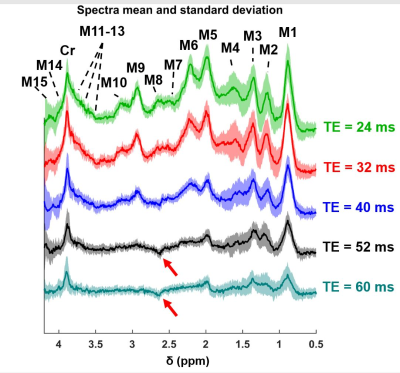 |
120 | T2 Relaxation Times of Macromolecules in Human Brain Spectra at 9.4 T
Tamás Borbáth, Saipavitra Murali Manohar, Andrew Wright, Anke Henning
This work reports the apparent T2 relaxation times of macromolecules measured at 9.4 T in the human brain. The measured T2 times are between 10 and 40ms, with longer relaxation times of around 50 ms for M2 and M3. The J-evolution of the peak at 2.7 ppm is observed at longer echo times. The full-width half-maxima of the simulated peaks are significantly broader than the T2 component of the lineshapes.
|
|
2245. 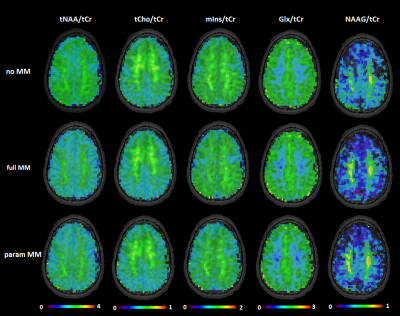 |
121 | What are the effects of adding macromolecules to the basis set on metabolite quantification reproducibility and accuracy? A comparison of different macromolecular models for FID-MRSI in the brain at 7T
Eva Heckova, Michal Považan, Bernhard Strasser, Stanislav Motyka, Gilbert Hangel, Lukas Hingerl, Philipp Moser, Stephan Gruber, Siegfried Trattnig, Wolfgang Bogner
This work investigates the influence of different macromolecular baseline models on the reliability and test-retest reproducibility of metabolite quantification for clinically attractive ~5min 2D-FID-MRSI with nominal voxel volume 3.4×3.4×8mm3. We confirmed that FID-MRSI with adequate MM prior knowledge provides highly reproducible (CV<11%) and reliable results (ICC>0.75) for the common metabolites even when using more flexible parameterized MM models.
|
|
2246. 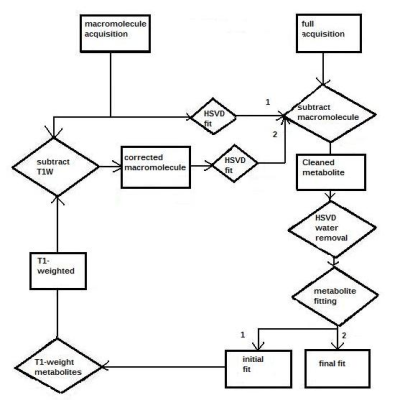 |
122 | An Analysis of 1H Metabolite Residuals in an Acquired Macromolecule Spectrum
David McAllindon, Chris Bowen, Denise Bernier, Philip Tibbo
Macromolecules underly the metabolites in short-TE 1H magnetic resonance spectroscopy and must be accounted for in a quantitative analysis. One method is to acquire a metabolite-nulled spectrum and use it to account for macromolecules in fitting; however, since metabolites have a range of T1, metabolite-nulling is incomplete and leaves residuals. We introduce a new metabolite cleaning method with 2 metabolite-nulling schemes, single inversion and double inversion, and use it to examine the estimated metabolite residuals, finding that even with double-inversion nulling, there are substantial metabolite residuals of 10-35% in the macromolecule spectrum.
|
|
2247. 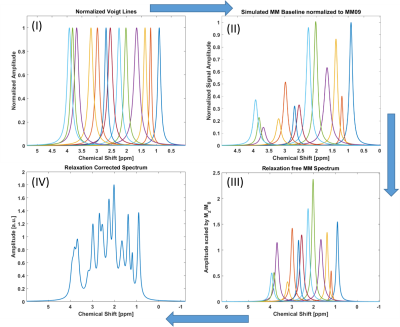 |
123 | Relaxation corrected and Sequence-dependent Macromolecule Baseline Model
Andrew Wright, Saipavitra Murali-Manohar, Anke Henning
In short echo time spectroscopy sequences macromolecular signals may strongly influence the quantification of metabolite spectra they underlay. In this work we present a method for simulating a MM basis set that is tailored toward chosen sequences and sequence parameters with the aim to improve the accuracy of metabolite measurements in vivo. We show that utilizing a simulated macromolecule basis set while considering the relaxation behavior of individual macromolecular resonances can produce metabolite quantification results of similar quality to that of a dedicatedly measured MM basis set when applied to the same spectra of interest.
|
|
2248. 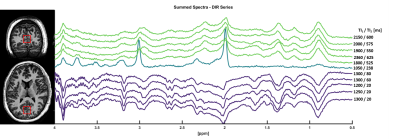 |
124 | Longitudinal Relaxation times of Macromolecular Resonances at 9.4 T in Human Brain
Saipavitra Murali-Manohar, Andrew Wright, Tamas Borbath, Anke Henning
Longitudinal relaxation times of 13 Macromolecular (MM) resonances are reported for a gray matter rich voxel at 9.4 T for the first time. In addition, a sequence was optimized based on calculated magnetizations from Bloch simulations for combinations of inversion times using a DIR MC-semiLASER. The results from this work highlight the importance of accounting for specific peak relaxations due to the ranging T1 relaxation times of the MM peaks.
|
|
2249. 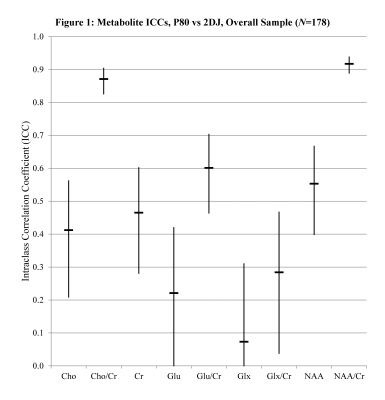 |
125 | Low Reliability between in vivo Measurements of Glutamatergic Metabolite Concentrations in Two Proton MR Spectroscopy Sequences
Charles Lewis, Paul Nakonezny, Mark Frye, Balwinder Singh, Paul Croarkin, John Port
Newer spectral sequences have been developed to focus quantification of specific metabolites. In this study, measurements of glutamatergic metabolites in a human sample (N=178) were compared between two sequences, a standard TE-optimized PRESS sequence designed to capture broad spectral resonance and a 2-dimensional J-resolved PRESS sequence developed specifically for glutamate signal acquisition at the expense of broad resonance capability. Cho/Cr and NAA/Cr measurements had good correspondence between sequences (intraclass correlation coefficients >0.88), while glutamate and related metabolites (Glu, Glu/Cr, Glx, Glx/Cr) demonstrated poor reliability. These findings emphasize the need to exercise caution when comparing glutamate measurements using different 1H-MRS sequences.
|
Digital Poster
| Exhibition Hall | 17:00 - 18:00 |
| Computer # | |||
2250. 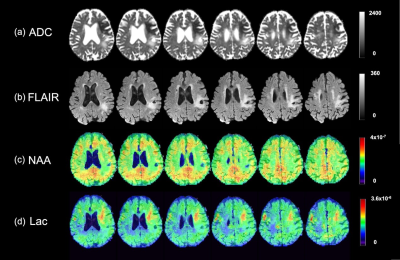 |
126 | Rapid High-Resolution Metabolic Imaging of Stroke Using SPICE
Tianxiao Zhang, Tianyao Wang, Ziyu Meng, Ke Xue, Yudu Li, Rong Guo, Yibo Zhao, Jun Liu, Zheng Jin, Xin Yu, Zhi-Pei Liang, Yao Li
Disrupted metabolic activity is one of the most prominent pathophysiologic consequences of stroke. 1H-MRSI has been recognized as a powerful tool for metabolic imaging, but its clinical applications have been limited due to long scan time and poor spatial resolution. In this study, we investigate the feasibility of rapid high-resolution metabolic imaging of stroke using SPICE (SPectroscopic Imaging by exploiting spatiospectral CorrElation). We have successfully acquired metabolic maps from the whole brain at a nominal spatial resolution of 2.0×2.4×2.0 mm3 in a 5-min scan. Our experimental results clearly show metabolic alterations due to stroke.
|
|
2251. 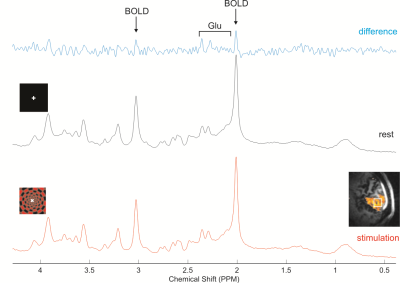 |
127 | Feasibility of functional spectroscopy at a clinical 3T MR scanner
Petr Bednarik, Alena Svatkova, Dinesh Deelchand, Rupert Lanzenberger, Wolfgang Bogner
Functional spectroscopy (
|
|
2252. 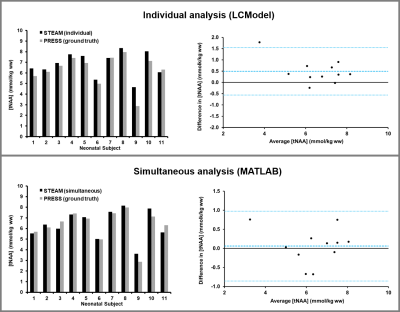 |
128 | Accurate Metabolite Quantification in the Presence Of Variable Lipids And Macromolecules: Two-Point Saturation Recovery MRS
Peter Lally, Alan Bainbridge, Paolo Montaldo, Vânia Oliveira, Josephine Mendoza, Sudhin Thayyil
In various pathologies, changes in cerebral metabolite concentrations are accompanied by variations in the broader underlying lipid/macromolecular components. This introduces important biases in quantification at short echo times which, if unaddressed, undermine experiments which compare subjects with different injury severities.
Here we demonstrate the benefits of employing a simple two-point saturation recovery MRS experiment to reduce this bias introduced by pathology – in this case, taking the example of neonatal encephalopathy. This ability to accurately quantify spectra at all pathology severities is crucial for clinical trials, where biases would otherwise suppress sensitivity to important treatment effects. |
|
2253. 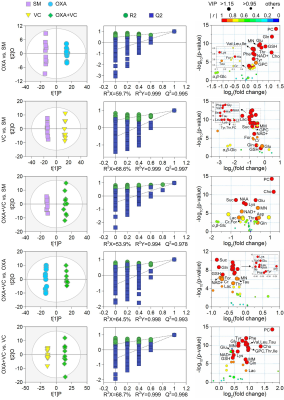 |
129 | 1H-NMR based metabolic profiles delineate the anticancer effect of vitamin C on hepatocellular carcinom cell
Caigui Lin, Zhiliang Wei, Jiyang Dong , Zhong Chen
Hepatocellular carcinoma (HCC) is a subtype of liver cancer with high worldwide prevalence and mortality. Its high recurrence rate and heterogeneity have challenged effectiveness of existing therapies. Numerous researchers explore the multifaceted benefits of Vitamin C (VC) in cancer treatments. In this study, we utilized the NMR-based metabolomics approach to systematically surrogate the molecular basis underlying the anticancer property of VC in HCC cell. Moreover, combination of VC with chemotherapeutic agent was tried to investigate synergetic effects in modulating metabolic profiles of cancer cells. Our results help to reveal the molecular basis of HCC treatment and may facilitate future clinical therapy designs.
|
|
2254. 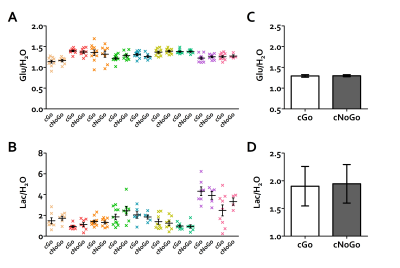 |
130 | Functional Magnetic Resonance Spectroscopy of response inhibition
Anouk Schrantee, Jannie Wijnen, Petra Pouwels, Niels de Joode, Wietske van der Zwaag, Liesbeth Reneman, Odile van den Heuvel, Chris Vriend
Ten volunteers performed a Go/NoGo task during MRS acquisition at 7T to assess if event-related fMRS could detect dynamic glutamate changes during response inhibition. Metabolite spectra were acquired using a semiLASER sequence (to assess task-induced fluctuations in glutamate and lactate) and were interleaved with water-unsuppressed spectra (to assess the BOLD response-induced water linewidth changes). The voxel was placed in the dorsomedial prefrontal cortex. Although an fMRI pilot confirmed the voxel location, no significant differences in metabolite concentrations or water amplitude between NoGo and Go trials was detected.
|
|
2255. 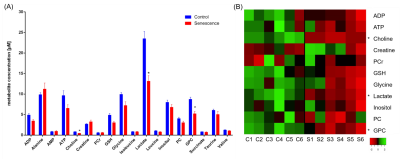 |
131 | MR compatible cell perfusion system allows investigating metabolism and invasion of hepatocellular carcinoma cells during p53 re-activation induced senescence
Philipp Knopf, Jesus Pacheco-Torres, Flonne Wildes, Christoph Trautwein, Benyuan Zhou, Balaji Krishnamachary, Lars Zender, Bernd Pichler, Zaver Bhujwalla
Here we investigated the metabolic characteristics and the effect of the so called senescence associated secretory phenotype (SASP) on extracellular matrix (ECM) degradation of p53 re-activation induced senescence, using a murine liver carcinoma cell model, where p53 is silenced in the presence of doxycycline hyclate. Senescence is induced within three days after doxycycline hyclate withdrawal and subsequent p53 re-activation. Our data revealed alterations of metabolites in p53-reactivation induced senescent H-Ras cells compared to control cells, including creatine, phosphocreatine and glycerophosphocholine indicating differences in energy and phospholipid metabolism. Senescent H-Ras cells tended to degrade the ECM more than control cells.
|
|
2256 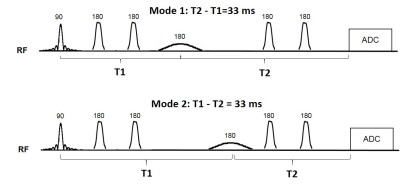 |
132 | Detecting contaminants with long T2 relaxation time at 3 ppm in the human brain using the novel antiphase J difference editing method implemented in proton MRS at 7T Video Permission Withheld
Seyedmorteza Rohani Rankouhi, Donghyun Hong, David Norris
In proton spectroscopy there are reports of macro-molecules (MM) in mobile form and therefore with long T2 relaxation time in the literature. Using the novel antiphase editing technique, we demonstrate the contribution of such contaminants to J-difference edited spectra at 3ppm, with implications for editing GABA.
|
|
2257. 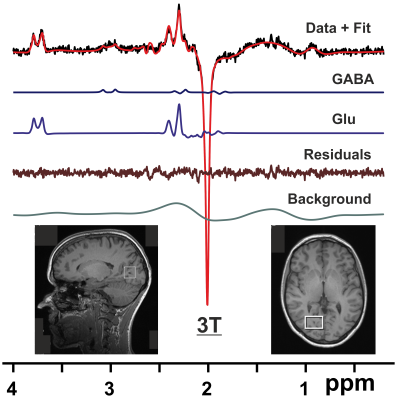 |
133 | Pharmacologically increased dopamine levels reduce GABA and glutamate concentrations in visual brain areas – a 1H MRS study at 3T
Ralf Mekle, Katharina Schmack, Jochen Fiebach, Heiner Stuke
Psychotic symptoms, such as delusions and hallucinations are frequently observed in schizophrenia. Converging evidence suggests a link to dompaminergic neurotransmission, although the underlying mechanisms are not well understood. In this study, dopamine levels were pharmacologically increased in healthy volunteers to investigate possible neurochemical alterations in the visual cortex measured by single volume 1H MRS using the MEGA-PRESS sequence at 3 T. Reduced GABA and decreased glutamate concentrations were found induced by increased dopamine levels. The former might contribute to the perceptual deficits seen in schizophrenia, while the latter supports the theory of glutamate hypofunction in schizophrenia.
|
|
2258. 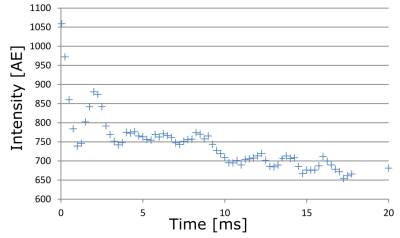 |
134 | Behavior of the signal components of collagen solutions in vitro using UTE-MRI and MRS sequences
Tobias Winkler, Petros Martirosian, Erwin Schleicher, Thomas Benkert, Fritz Schick
Collagen is a protein physiologically abundant in cartilage, tendons, and ligaments. Pathological processes in many organs might lead to accumulation of collagen in the extracellular space (eg, in hepatic, muscular or renal fibrosis), and non-invasive assessment of fibrotic changes in parenchyma is of high clinical interest. Ultrashort echo-time (UTE) sequences provide direct assessment of the fast decaying signals of collagen. In this work collagen solutions were analyzed in vitro with inversion recovery FID and spin echo spectroscopy sequences to get a better understanding of the different spectral components of collagen signals and their behavior using a 3T whole-body scanner.
|
|
2259. 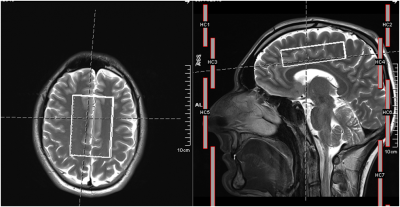 |
135 | Detection of NAD+ in human brain is possible even at 3T and in spite of water pre-saturation when using a large voxel size
Maike Hoefemann, Malgorzata Marjanska, Edward Auerbach, Roland Kreis
The detection of Nicotinamide adenine dinucleotide (NAD+) proved to be challenging in 1H Magnetic Resonance Spectroscopy, as standard water presaturation showed to lead to a strong suppression of NAD+ signals due to the polarization exchange between NAD+ and water. For the detection of such low-concentration metabolites, a high Signal-to-Noise-Ratio (SNR) is crucial. One possibility to increase the SNR is to choose a large voxel size (VS). In this study we show that optimizing acquisition parameters focusing on high SNR and increasing the VS to 75 cm3 allows the detection of NAD+ at 3T with a semi-LASER sequence despite water presaturation.
|
|
2260. 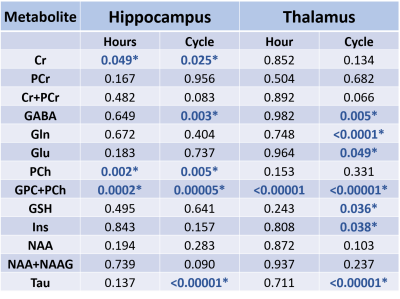 |
136 | Effects of Anaesthetic Duration and Time of Day on Metabolite Levels in Long Evans Rat
Wendy Oakden, Greg Stanisz
The type and dose of anaesthesia affects both cerebral blood flow and metabolism. For experiments which involve measuring small changes in neuro-chemical levels either between groups, or following treatment, any differences in experimental conditions which increase the amount of variability can either mask or alter the results. Using 1H MRS, metabolites were quantified hourly in hippocampus and thalamus over the course of 5 hours under light isoflurane anaesthetic, in rats exposed to either a normal or a reversed light cycle. Both anaesthesia duration and light cycle had statistically significant effects on some, but not all, metabolites.
|
|
2261. 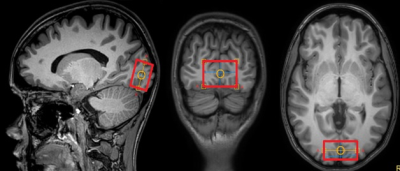 |
137 | Functional MRS of aspartate, glutamate, glutamine and GABA- at 3 Tesla
Andrei Manzhurtsev, Alexey Yakovlev, Petr Menshchikov, Maxim Ublinskiy, Tolib Akhadov, Natalia Semenova
In this research visual stimulation was used for the first functional MRS of aspartate, TE averaging – for pure glutamate and glutamine, and MEGA-PRESS for GABA- to find activation-induced changes at 3 Tesla. The results (except for glutamine) are in compliance with previously published data for 7T. The parameters behavior might reflect the manifestation of Glu neurotransmitter function predominance and metabolic character of changes in the concentrations of other parameters studied.
|
|
2262. 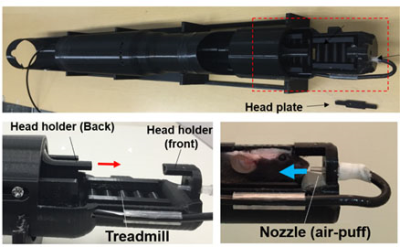 |
138 | Long-term sensory stimulation causes slow GABA rise after fast glutamate rise: E/I balance monitored by 1H-MRS in awake mice brain
Yuhei Takado, Hiroyuki Takuwa, Manami Takahashi, Masafumi Shimojo, Takuya Urushihata, Nobuhiro Nitta, Sayaka Shibata, Jamie Near, Maiko Ono, Jun Maeda, Naruhiko Sahara, Yutaka Tomita, Ichio Aoki, Tetsuya Suhara, Makoto Higuchi
To clarify different temporal alterations of Glutamate (Glu) and GABA levels for excitatory/inhibitory (E/I) balance during neural activity in awake healthy mice, we performed 1H-MRS during whisker stimulation. The
|
|
2263. 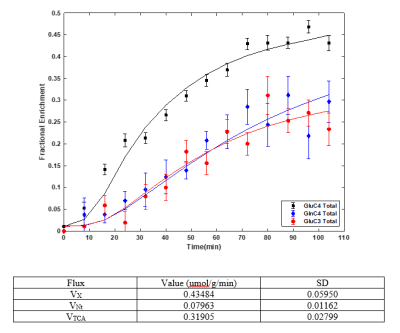 |
139 | Indirect 1H-[13C] NMR Spectroscopy in Rodent Alzheimer’s Model
Steven Zhang, Masoumeh Dehghani, Jim Gourdon, Chathura Kumaragamage, Jamie Near
Alzheimer’s disease (AD) is a neurodegenerative disorder commonly associated with neuronal metabolic deficits. In this study, we employ an indirect 1H-[13C] MRS approach to investigate changes in glucose metabolism between wild type and transgenic Alzheimer rats. This method can be used to follow the labeling of downstream metabolites after [1-6,13C2] glucose infusion and allows for quantitative measurements of the rate of 13C-label transfer from glucose into glutamate and glutamine in the brain. Preliminary comparison of 13C fractional enrichment time courses suggest that transgenic rats exhibit slower 13C metabolite labeling, indicative of a lowered glucose metabolic rate in AD pathology.
|
|
2264. 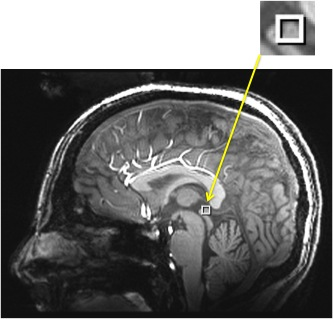 |
140 | Feasibility of Single Voxel Proton Spectroscopy of Pineal Gland at 7T
Ravi Prakash Reddy Nanga, Deepa Thakuri, Sanjeev Chawla, Dushyant Kumar, Abigail Cember, Hari Hariharan, Cynthia Epperson, Ravinder Reddy
Taurine is an important metabolite present in the pineal gland and is involved in the regulation of melatonin, which is plays a key role in regulation of sleep-wake cycle, in endocrine metabolism and in depression. However, there have been no known in vivo studies that measured neuro-metabolites in the pineal gland. In this study, for the first time, we explored the feasibility of single voxel proton spectroscopy from pineal gland in vivo in healthy human volunteers at 7.0T MRI.
|
|
2265. 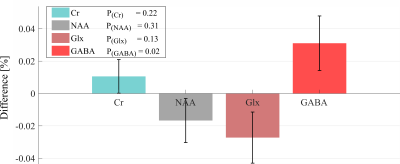 |
141 | MRS reveals motor cortex basal GABA levels are correlated with handedness
Yasmin Geiger, Assaf Tal
Motor skills acquisition can manifest in changes in basal levels of metabolites in the motor cortex. We aim to study difference in metabolites basal levels in the ipsilateral and contralateral motor cortex using single voxel MRS. Our study showed significant difference only in basal GABA levels and the basal GABA/Glx ratio. This result should be kept in mind when interpreting or designing experiments studying the metabolic correlates of motor function.
|
|
2266. 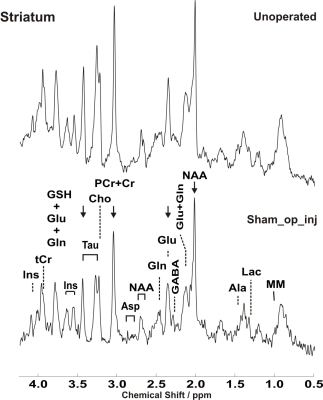 |
142 | Impact of Cannula Implantation on Neurochemical Profile in juvenile rat model for ADHD @ 11.7T
Alireza Abaei, Dinesh K Deelchand, Francesca Rizzo, Tobias M. Böckers , Volker Rasche
To detect subtle changes in the neurometabolite concentrations by MRS, it is of utmost importance that the dominant contribution to the metabolic changes, is caused by the pathology of interest itself. Many studies involve surgery to interface e.g. cannulas to the brain. We investigate the impact of implanting an intracerebral cannula on the striatal neurochemical profile. MRS of the striatum from both hemisphere was performed 14d after surgery. A significant reduction of almost all metabolites was observed in the hemisphere with cannulation as well as contralateral side, indicating a dominant impact of the surgery, which might impact the sensitivity of MRS for quantification of pathologic processes.
|
|
2267. 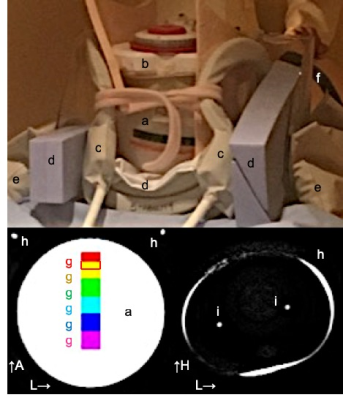 |
143 | Initial observations of position-dependent B0 distortions in a concurrent TMS/MRS phantom experiment
Leo Sporn, Erin MacMillan, Ruiyang Ge, Afifa Humaira, Laura Barlow, Cornelia Laule, Fidel Vila-Rodriguez
There is interest in using MRS to study the effects of transcranial magnetic stimulation (TMS), but a major challenge is B0 inhomogeneities introduced by the TMS coil. Phantom work showed increasing B0 inhomogeneity as the MRS voxel was moved closer to the TMS coil. Distortions in the metabolite signals included increased noise fluctuations and spectral linewidth by ~50% when the voxel center was < 6cm away from the TMS coil B0 inhomogeneity effects were similar whether the TMS coil was pulsing prior to the PRESS sequence or not. Our results suggest TMS/MRS may be able to resolve spectra in vivo.
|
|
| 2268. |
144 | The association between plasma and brain glutamine and glutamate in healthy volunteers probed by LC-MS and 1H-MRS
Naoto Sato, Yuhei Takado, Yuta Kanbe, Moyoko Tomiyasu, Lijing Xin, Jamie Near, Kohki Yoshikawa, Tatsuya Higashi, Tetsuya Suhara, Makoto Higuchi, Takayuki Obata
The present study aimed to evaluate the association between the plasma and brain glutamine (Glu) and glutamate (Gln) using proton magnetic resonance spectroscopy (1H-MRS) and liquid chromatography-electrospray ionization-tandem mass spectrometry (LC-MS), respectively, in 20 participants. A positive correlation between Gln to
|
|
2269. 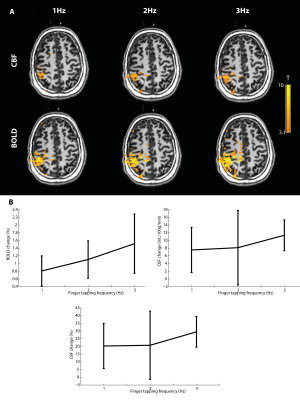 |
145 | Modulation of brain oxidative and glycolytic metabolisms using a finger tapping task: an ASL-fMRI and fMRS study
Yohan Boillat, Lijing Xin, Olivier Reynaud, Wietske van der Zwaag, Rolf Gruetter
Using [Lac] and [Glu] as markers of glycolytic and oxidative metabolisms, respectively, we investigated the involvement of each of these pathways during a finger tapping task at different frequencies. We measured BOLD and CBF data and metabolite concentrations at 7T. BOLD and CBF signals increased for increasing finger tapping frequencies as well as [Lac]. The [Glu] changes were smaller and, with the current number of participants, did not follow the same trend.
|
|
2270. 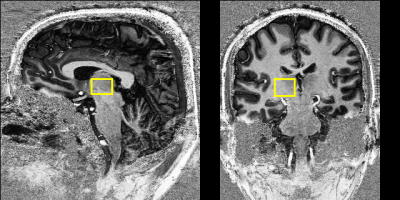 |
146 | Neurochemical measurement in the thalamus: a test-retest study at 7T
Song-I Lim, Masoumeh Dehghani, Rolf Gruetter, Lijing Xin
Thalamus has been known as a critical hub through which bidirectional neural signals are transmitted between
|
|
2271. 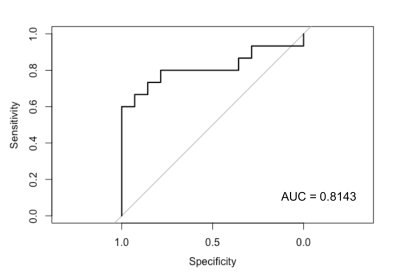 |
147 | Sex-Related Choline Differences Detected in Posterior Cingulate Gyrus of Healthy Controls
Molly Charney, Eduardo Coello, Tyler Starr, Huijun Liao, Alexander Lin
There has been little consensus over the existence of sex-related neurochemical differences in the human brain. This analysis reveals a significant difference in tCho/tCr in the posterior cingulate gyrus of males and females of a large age range. These results indicate that sex should be considered in study recruitment, disease progression, and treatment following injury.
|
|
2272. 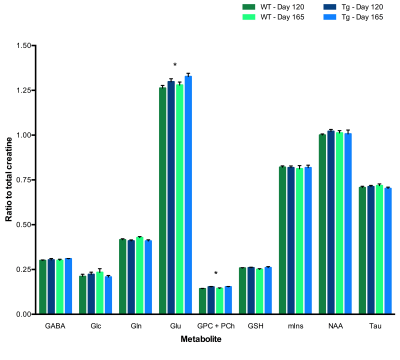 |
148 | Characterizing the relationships between early systemic cytokine levels and neurochemical changes in Alzheimer’s disease: A longitudinal neuroimaging study in the TgF344-AD rodent model
Katrina Cruickshank, Tak Pan Wong, Jamie Near
Cytokines are chemical signalling molecules released by the immune system in response to pathological insults. Cytokine upregulation is an early feature of Alzheimer’s disease (AD) and a possible contributor to downstream neuropathology and cognitive decline. Using magnetic resonance spectroscopy (MRS), cytokine-specific enzyme-linked immunosorbent assays (ELISA) and behavioural measures, we aimed to investigate the relationships between cytokine activity, early neurochemical changes and cognitive decline in an AD rodent model. Preliminary metabolic alterations suggest a paradoxical increase in synaptic activity, coinciding with cognitive deficits. This ongoing study is a step towards understanding the impact of abnormal cytokine levels on the AD brain.
|
|
2273.  |
149 | 1H MRS assessment of lipid composition at 3T and 7T
Stephen Bawden, Scott Willis, Hannah Williams, James King, Guruprasad Aithal, Penny Gowland
MRI and MRS provides a powerful tool to non-invasively assess lipid deposition in vivo. In addition to fat fraction measurements, recent studies have shown that lipid composition may play an important role in health outcomes. 1H MRS at high field strength provides good SNR of individual fat peaks and can be used to asses lipid composition (saturation, poly-unsaturation etc.). In this study a number of edible oils were scanned at 3T and 7T and MR spectra used to compare measurements of lipid composition with predicted values. An in vivo dataset was also acquired for comparison.
|
|
2274 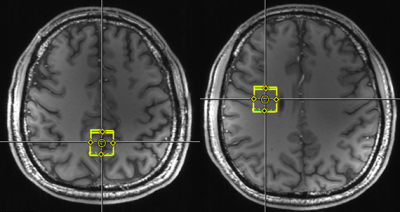 |
150 | Distribution pattern of neurotransmitters and antioxidants in human brain: a 1H-MRS study at 7 T Video Permission Withheld
Jun-ichiro Enmi, Ikuhiro Kida, Seishi Itoi, Tetsuya Shimokawa, Noriaki Hattori, Yoshichika Yoshioka
The concentrations of some neurotransmitters (N–acetylaspartylglutamate (NAAG), glutamate (Glu), and γ-aminobutyric acid (GABA)) and some antioxidants (glutathione (GSH), ascorbic acid (Asc), and taurine (Tau)) were measured in human brain gray and white matters by using 1H-MRS at 7 T. The distribution patterns of NAAG, Glu, and GABA were completely different from each other. The distribution patterns of the antioxidants had a relatively similar tendency. The concentrations of Asc and Tau were significantly higher in gray matters than in white matters, although there was no significant difference in GSH concentration between the gray and white matter.
|
Digital Poster
| Exhibition Hall | 17:00 - 18:00 |
| Computer # | |||
2275. 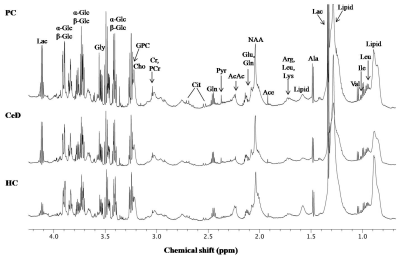 |
151 | Potential Celiac disease (CeD) patients may serve as pre-clinical model to understand pathogenesis of Celiac Disease: A NMR metabonomics approach
Deepti Upadhyay, Naranamangalam Jagannathan, Govind Makharia , Siddharth Gupta, Prasenjit Das, Uma Sharma
Potential celiac disease (CeD) patients have positive CeD associated antibodies (anti-tissue tansglutaminase antibodies) and HLA-DQ2 and/or HLA-DQ8 genotype but no intestinal inflammation. NMR based metabonomic study of blood plasma of potential CeD patients demonstrated a distinct metabolic fingerprint characterized by raised histidine and proline in comparison to healthy controls. The changes in histidine suggested compromised cytoprotective mechanism while elevated arginine level indicated altered functioning of intestinal cells in potential CeD. These altered metabolic activities could be the initial event that precede the pathogenesis of CeD and may contribute to intestinal inflammation which results in villous atrophy.
|
|
2276. 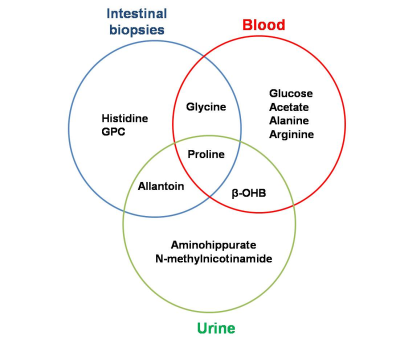 |
152 | Role of combining NMR metabolomics data of intestinal mucosal biopsies, blood plasma and urine for determining biomarker/s for Celiac Disease (CeD)
Deepti Upadhyay, Prasenjit Das, Siddharth Gupta, Govind Makharia , Naranamangalam Jagannathan, Uma Sharma
NMR based metabonomics of small intestinal mucosal biopsies, blood plasma and urine samples from same set of patients demonstrated the underlying biochemical abnormalities and biomarker/s for celiac disease (CeD). Intestinal mucosa of CeD patients had higher levels of proline and allantoin while lower glycine, histidine and GPC compared to controls. Metabolome of blood plasma of CeD patients showed significantly higher concentration of proline, arginine and β-hydroxybutyrate while urine had higher proline, allantoin and β-hydroxybutyrate compared to healthy controls. These findings indicated metabolic abnormalities associated with villous atrophy seen in CeD and suggested proline, arginine and allantoin may serve as biomarker/s.
|
|
| 2277. |
153 | Blood plasma metabolic profiling discriminates prostate cancer patients with metastases from those without metastases
Naranamangalam Jagannathan, Pradeep Kumar, Rajeev Kumar, Virendra Kumar, S. Senthil Kumaran, Sanjay Sharma, Sanjay Thulkar, S. Datta Gupta
The present study evaluates the metabolic profile of blood plasma for distinguishing prostate cancer (PCa) patients with metastases (n=30) and without metastases (n=35) using 1H-NMR spectroscopy. Our data showed significant lower concentration of leucine, valine, isoleucine, glycerophosphocholine, glutamine and acetoacetate in PCa patents with metastases as compared to patients without metastases. Results provided an insight into the alterations in the metabolic pathways in PCa and indicated that NMR spectroscopy may help in determining potential biomarker/s for the diagnosis of PCa patients with metastases.
|
|
2278. 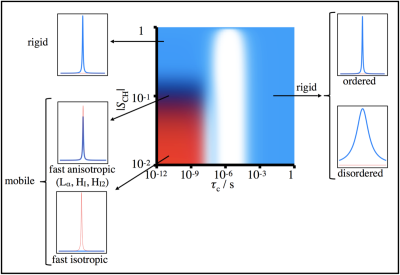 |
154 | Evaluation of Bovine Brain Extract Phantom Structure through Polarization Transfer Solid-State NMR
William Reichert, Quoc Pham, Mark Does, Daniel Topgaard
Myelin MRI phantoms used to characterize magnetization dynamics require comparable microstructure and composition to physiological myelin for experiments to be translatable. Folch Fraction I bovine brain extract was evaluated for its phase behavior, composition, and structure through Polarization Transfer solid-state NMR (PT ssNMR), 31P static NMR, and small-angle X-ray scattering. Results indicate the absence of cholesterol and the coexistence of solid and liquid isotropic phases in phantoms across various solvent contents at body temperature, as opposed to physiological myelin's multi-lamellar liquid crystalline structure. Experiments aimed at characterizing myelin’s microstructure should look to other preparation methods.
|
|
2279. 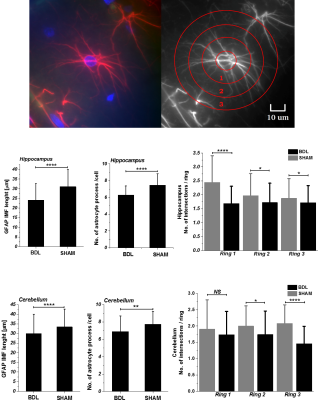 |
155 | Brain regional susceptibility to Oxidative Stress in a rat model of Chronic Hepatic Encephalopathy: in-vivo 1H MRS, ex-vivo ESR spectroscopy and histology findings
Katarzyna Pierzchala, Dunja Simicic, Veronika Rackayova, Olivier Braissant, Dario Sessa, Stefanita Mitrea, Andrzej Sienkiewicz, Valérie McLin, Rolf Gruetter, Cristina Cudalbu
Oxidative stress (OS) is thought to be an important factor in chronic hepatic encephalopathy (CHE) pathogenesis. Combining in-vivo 1H-MRS, ex-vivo ESR and histology of CNS allowed us to investigate the course and brain regional difference of cerebral OS in the rat model of CHE. Early changes in brain antioxidants (Asc and GSH, post-BDL) were validated by ESR and histology. Our results showed a stronger vulnerability of cerebellum and confirmed that the antioxidant system impairment and central OS is an early event in CHE.
|
|
2280. 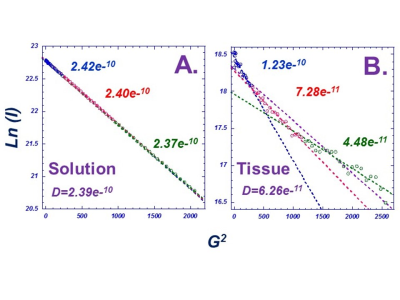 |
156 | Probing Cellular Metabolite Diffusion Characteristics for Intact Human Prostate Tissue with HRMAS Diffusion Ordered MRS
Samuel Hernandez, marlon tilgner, Peter Caravan, Leo Cheng
Prostate Cancer (PCa) is the second leading cause of cancer death among men, however, in clinic at present, there is still a lack of sensitive biomarkers that can assist accurate diagnoses for PCa patients. Our laboratory has been engaged in the discovery of PCa metabolomic markers in the past decade using intact tissue high-resolution magic angle spinning magnetic resonance spectroscopy (HRMAS MRS). In this study, we further our endeavor by investigations of prostate tissue with diffusion ordered MRS to include the physical properties of cellular metabolites through evaluations of their diffusion characteristics.in the biomarker discovery.
|
|
2281. 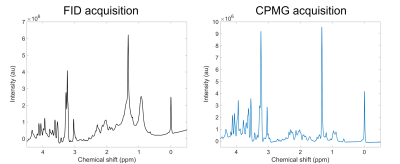 |
157 | Comparison of LCModel fitting of HRMAS spectra acquired from malignant glioma tissue using free induction decay and Carr-Purcell-Meiboom-Gill pulse sequences
Selin Ekici, Ren Geryak, Candace Fleischer
Gliomas are a class of aggressive brain tumors with a low survival rate. New biomarkers are needed to monitor tumor progression and response to treatment. Our goal was to compare the effectiveness of operator-independent LCModel analysis for HRMAS NMR spectra acquired from histologically confirmed glioma tissue (n=14) using both FID and CPMG pulse sequences. The CRLBs of lactate and myo-inositol were significantly lower for spectra acquired with the CPMG compared to the FID sequence. Relevant glioma metabolites were quantified with LCModel from most spectra acquired with CPMG but not FID.
|
|
2282. 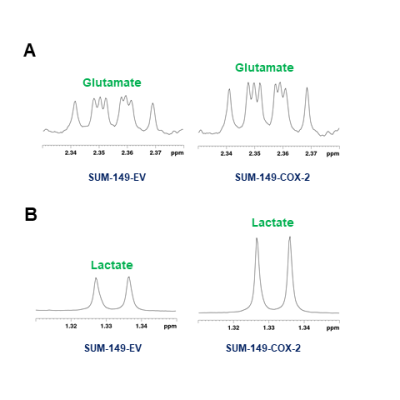 |
158 | Tumor COX-2 overexpression in triple negative breast cancer alters spleen metabolism
James Barnett, Santosh Bharti, Balaji Krishnamachary, Flonne Wildes, Yelena Mironchik, Marie-France Penet, Zaver Bhujwalla
Cyclooxygenase-2 (COX-2) is an inducible enzyme that mediates the inflammatory response of cells. COX-2 overexpression is associated with poor prognosis in breast cancers. Here we have investigated the effect of tumor COX-2 overexpression on spleen metabolism, using 1H magnetic resonance spectroscopy (MRS), as part of an overall focus on understanding the impact of cancers on inducing metabolic changes in critical organs. We focused on the spleen since it plays a critical role in the immune response and detected distinct differences in glutamate and lactate with COX-2 overexpression.
|
|
2283. 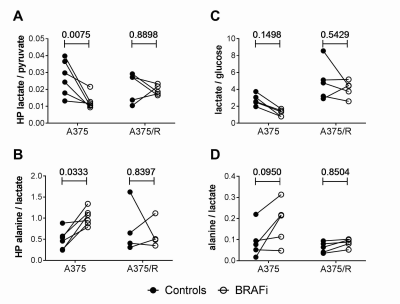 |
159 | Metabolic profiling discriminates between BRAFi sensitive and BRAFi resistant melanoma cells
Stefania Acciardo, Lionel Mignion, Florian Gourgue, Céline Schoonjans, Nicolas Joudiou, Bernard Gallez, Bénédicte Jordan
The aim of this work is to identify a marker of response or resistance to BRAF inhibition in melanoma. BRAF inhibition resulted in a decrease of 13C label exchange between hyperpolarized [1-13C]pyruvate and lactate in sensitive, but not in resistant, melanoma cells. Such effect is likely to be mediated by a reduction of the lactate pool due to (i) decreased flux through glycolysis, (ii) reduced MCT1-mediated lactate uptake and (iii) increased lactate efflux via MCT4. The lactate/pyruvate ratio may help to discriminate between sensitive and resistant melanoma cells, by reflecting the different metabolic alterations that the cells undergo.
|
|
2284. 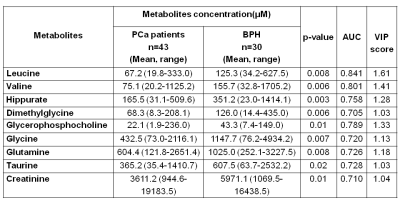 |
160 | Metabolomics study of urine discriminates prostate cancer (PCa) patients from benign prostatic hyperplasia (BPH) by 1H NMR spectroscopy
Pradeep Kumar, Rajeev Kumar, Virendra Kumar, S. Senthil Kumaran, Sanjay Sharma, Sanjay Thulkar, S. Datta Gupta, Naranamangalam R. Jagannathan
The present study demonstrates the potential of proton nuclear magnetic resonance (1H-NMR) based metabolic profiling of urine for distinguishing prostate cancer patients (PCa; n=43) from patients with benign prostatic hyperplasia (BPH; n=30) and to determine non-invasive biomarker/s for diagnosis. A significantly lower concentration of leucine, valine, hippurate, dimethylglycine, glycerophosphocholine, glutamine, glycine, taurine and creatinine were observed in PCa patients as compared to BPH. Our result suggests metabolic alterations due to protein turnover, cell proliferation, energy demand and gut micro-biota metabolism in PCa patients.
|
|
2285. 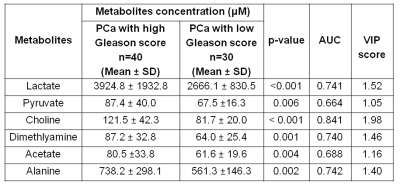 |
161 | High-grade and low-grade prostate cancer discrimination via blood plasma NMR based metabolomics
Pradeep Kumar, Rajeev Kumar, Virendra Kumar, S. Senthil Kumaran, Sanjay Sharma, Sanjay Thulkar, S. Datta Gupta, Naranamangalam R. Jagannathan
This study investigates the metabolic profile of blood plasma for distinguishing prostate cancer (PCa) patients with high Gleason score (GS≥7) and low Gleason score (GS<7) using 1H-NMR metabolomics. A significantly higher concentration of lactate, pyruvate, choline, dimethylamine, acetate and alanine were observed in the blood plasma of PCa patients with high Gleason score as compared to patients with low Gleason score. Our results suggested that the metabolic pathway alterations seen in amino acids, choline, glucose and ketone body may be related to changes in PCa progression.
|
|
2286 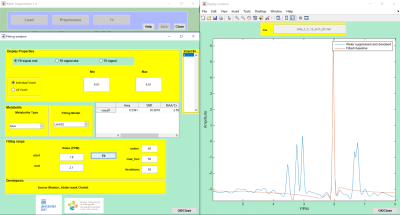 |
162 | Matlab Tool for Residual Water Suppression and Denoising of MRS Signal using the Schrodinger operator Video Permission Withheld
Abderrazak Chahid, Sourav Bhaduri, Eric Achten, Taous-Meriem Laleg-Kirati, Hacene Serrai
A new user interactive platform for MRS data processing is proposed. This toolbox is based on the Semi-Classical Signal Analysis (SCSA) for Residual Water Suppression and MRS signal denoising. It allows MRS users to achieve water suppression and data denoising, with data fitting as an additional feature. The toolbox is easy to install and to use: 1) visualization of spectroscopy data, 2) water suppression and denoising, 3) iterative data fitting using nonlinear least squares. This abstract demonstrates how each of these features has been incorporated and provides technical details about the implementation as a graphical user interface in MATLAB.
|
|
2287. 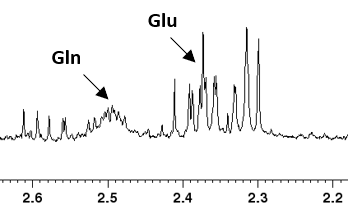 |
163 | Investigating the Role of Glutamine Transporters in Breast Cancer
Caitlin Tressler, Vinay Ayyappan, Kanchan Sonkar, Kristine Glunde
We are investigating aberrant glutamine metabolism in breast cancer to discover potential novel therapeutic targets to inhibit a critical energy source for cancer cells. We have examined glutamine and glutamate levels using 1H magnetic resonance spectroscopy (MRS) across multiple breast cancer cell types and have begun to look at the molecular mechanisms of glutamine addiction using qRT-PCR. We identified SLC38A3 to be overexpressed in nearly every breast cancer cell line examined, which may, in the future, serve as a potential target in breast cancer.
|
|
2288. 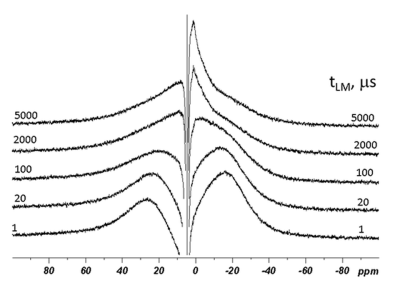 |
164 | Multi-exponential decay of dipolar order in spinal cord and its correlation to spin diffusion
Uzi Eliav, Gil Navon, Peter Basser
Images obtained by inhomogeneous magnetization transfer were analyzed using models involving Zeeman and dipolar orders. These orders are affected by spin diffusion and relaxation. In the current study a method that enables the measurement of these processes in spinal cord by the same pulse sequence is presented. Magnetization transfer time (MT, spin diffusion) between CH2 groups is ~0.1ms while the MT between them and CH3 groups is much slower (~2ms). The dipolar order is found to decay by three exponentials process (0.11, 0.86, 11.4ms). The fastest decaying component is compatible with the spin diffusion between the CH2.
|
|
2289.  |
165 | Magnetic Resonance Spectrum Simulator (MARSS): Software for Fast and Reliable Simulation of Spin Systems
Karl Landheer, Kelley Swanberg, Christoph Juchem
Accurate density matrix simulation of nuclear spin systems is critical for quantifying magnetic resonance spectroscopy (MRS) data, as well as for simulation studies designed to optimize acquisition parameters. Although a variety of packages exist to achieve this result, no currently available software is capable of computing a large number of spatial points in a reasonable time frame. Here we present and experimentally validate a novel MATLAB-based software package able to compute complex spin systems, including those exhibiting scalar coupling like GABA, for 643 spatial points within 25 minutes.
|
|
2290 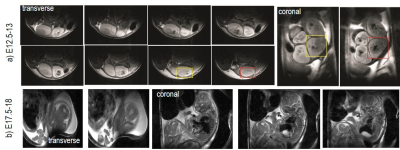 |
166 | Neurochemical evolution of murine embryonic brain, an in vivo 1H MRS study at 14.1T Video Permission Withheld
Hongxia Lei, Jean-Claude Martinou
1H MRS study of embryonic brain development is feasible and offers valuable insights towards early brain development in utero.
|
|
2291. 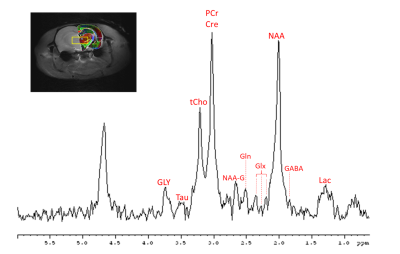 |
167 | Assessment of Thalamic Metabolic Processes in a Migraine Model: A Relaxation Enhanced Diffusion Weighted MRS Study at 21.1 T
Nastaren Abad, Jens Rosenberg, Tangi Roussel, Michael Harrington, Samuel Grant
To date, there is a lack of characterization of metabolic markers in migraine studies. Though numerous studies implicate cerebral dysfunction, robust biomarkers are yet to be identified in the migraine brain. It thus follows that identification of specific metabolic changes, potentially influenced by excitatory and inhibitory neurotransmitters, may improve understanding of migraine onset and propagation while opening new avenues for therapy development. With the goal of evaluating metabolic processes, diffusion-weighed spectroscopy is used to identify longitudinal changes in the in vivo thalamus of an acute rodent of migraine model. |
|
2292. 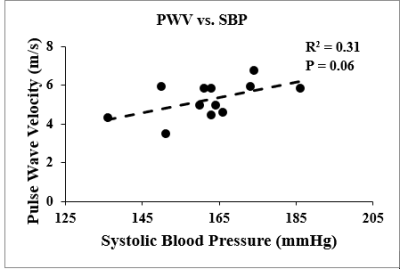 |
168 | Association of central arterial stiffness with hippocampal blood flow and N-acetyl aspartate in hypertensive Dahl salt sensitive rats
Samuel Ajamu, Rachel Fenner, Yulia Grigorova, James Karchner, Edward Lakatta, Mustapha Bouhrara, Richard Spencer, Olga Fedorova, Kenneth Fishbein
Central arterial stiffness (CAS) is associated with hypertension and is likely associated with stiffening of cerebral artery walls, with attendant cerebral hypoperfusion, neuronal density loss and cognitive decline. We sought to explore associations between pulse wave velocity (PWV), a marker of CAS, and hippocampal blood flow and neuronal density in hypertensive Dahl salt sensitive (Dahl-S) rats, which exhibit age-associated memory loss. We observed direct correlations between greater PWV, lower cerebral blood flow (CBF) and lower N-acetyl aspartate/total creatine ratio (NAA/tCr) in the hippocampus, supporting the role of CAS in cerebrovascular dysfunction and decline in cognitive performance with hypertension and aging.
|
|
2293. 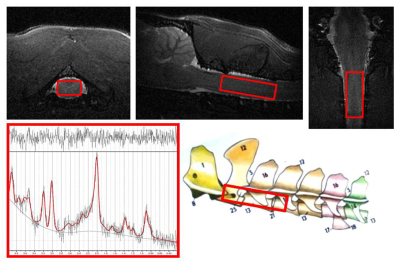 |
169 | Alteration in 1H MRS metabolites in the rat spinal cord after experimental craniospinal irradiation
Petra Hnilicová, Sona Bálentová, Dagmar Kalenská , Eva Hajtmanová , Peter Murín , Michal Bittšanský, Marian Adamkov , Ján Lehotský, Dušan Dobrota
We investigated the metabolic effect of a clinically relevant craniospinal irradiation on the rat spinal cord using 1H MRS at 7T. Hundred days after the fractionated irradiation performed by radioactive isotope 60Co (16Gy in 2 fractions), irradiated and sham-irradiated animals underwent in vivo 1H MRS examination. Spinal cord spectra were measured by SVS sequence with voxel size of 3.5x2x7.5mm3. In spinal cord of irradiated animals was confirmed significantly reduced tNAA/tCr and increased tCho/tCr ratio, both showing demyelination and inflammatory processes. It seems that in vivo 1H MRS of spinal cord could be useful for radiation therapy monitoring.
|
|
2294. 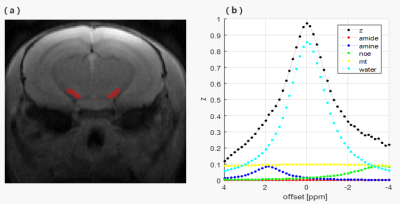 |
170 | Quantifying the CEST@2ppm from 5-pool Lorentzian fitting in the substantia nigra of acute MPTP mouse models at 7 Tesla Presentation Not Submitted
Guojing Wei, Yanqiu Feng
Non-invasive and quantifiable diagnosis of Parkinson’s disease is an ongoing challenge for researchers. In this study, we worked on the CEST signal at 2ppm (CEST@2ppm) in the substantia nigra of acute 1-methyl-4-phenyl-1,2,3,6-tetrahydropyridine (MPTP) mouse models at three different time points including pre and 3rd day, 10th day after treatment. CEST@2ppm after 5-pool lorentzian fitting showed a statistically significant difference after MPTP injection and metrics based on this fitting model ( MTRrex and AREX) also indicated positive correlation of CEST@2ppm with the SN damages while the statistic difference of 3rd and 10th day was not significant. This quantifying CEST signal may reflect the pathological mechanism of PD in SN.
|
|
2295. 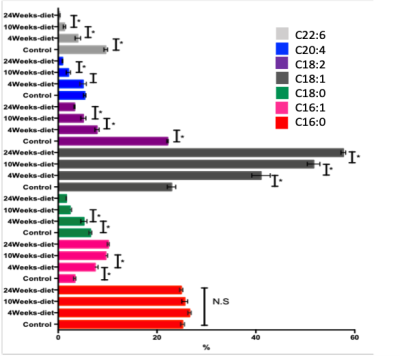 |
171 | Ex vivo quantification of hepatic fatty acid in mice fed with western-diet using magnetic resonance spectroscopy at 9.4 T
Aline Xavier, Flavia Zacconi , Daniel Cabrera , Marco Arese, Marcelo Andia
The idea of defining a biomarker to assess the progression of Nonalcoholic Fatty Liver Disease (NAFLD) by using Magnetic Resonance Spectroscopy (MRS) emerges due to the need to find a way to replace biopsy with a non-invasive method. The purpose of this study is to investigate the composition of the liver fatty acids based in the metabolite signals in MRS in NAFLD mice fed with a western-diet at 3 time-point during the progression of the disease. Our findings showed significant changes in the diallylic (2.8 ppm), olefinic (5.3ppm), allilic (2.0 ppm) and bulk methylene (1.3 ppm) peaks during the progression of the NAFLD by using high-resolution MRS.
|
|
2296. 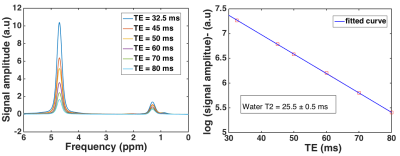 |
172 | Water T2 is altered with hepatic lipid fraction at 3 Tesla
Pandichelvam Veeraiah, Julian Mevenkamp, Ine Telgenkamp, Nynke Simons, Martijn Brouwers, Joachim E Wildberger, Patrick Schrauwen, Vera B Schrauwen-Hinderling, Lucas Lindeboom
1H-MRS is extensively used to measure the hepatic lipid content. Conventionally, the water resonance is used as an internal reference, thereby assuming a constant T2decay of water across individuals to estimate absolute hepatic lipid content. However, the T2 values reported in literature for 3T vary widely, which might be due to different subject populations and/or other methodological discrepancies. The purpose of this study was to measure T2 of water in a group of subjects with a wide range of hepatic lipid content and to evaluate whether there is a dependence of water T2 relaxation times and hepatic lipid fraction.
|
|
2297. 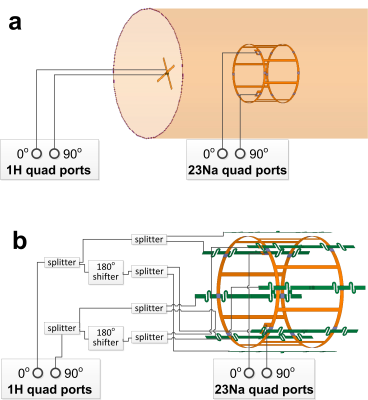 |
173 | Numerical analysis of different dual-tuned coils for head and knee imaging at 7T
Xinqiang Yan, Rachelle Crescenzi, John Gore
A recurring need in MRI and MRS is to acquire signals from multiple nuclei, 1H proton
|
|
2298. 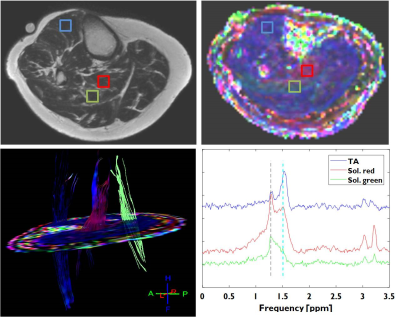 |
174 | Diffusion tensor and Dixon imaging for guiding proton magnetic resonance spectroscopic evaluation of intra and extra myocellular lipids in skeletal muscle
Jiming Zhang, Claudio Arena, Afis Ajala, Luning Wang, Rajagopal Viswanatah Sekhar, Raja Muthupillai
A different level of overlap between intramyocellular and extramyocellular lipids signal (EMCL and IMCL) depends on muscle fiber orientation and interstitial/fascial muscle fat tissue. We proposed diffusion tensor imaging and Dixon reconstructed fiber orientation map and maximum intensity projection fat maps to guide MR spectroscopy acquisition by carefully positioning the voxel so as to minimize these two effects. This method can be used to improve the consistency and accuracy of using MRS to quantify the intra skeletal muscle lipids and minimize variability in longitudinal studies such as evaluating disease progression or monitoring treatment progress
|
 Back to Program-at-a-Glance |
Back to Program-at-a-Glance |  Back to Top
Back to Top